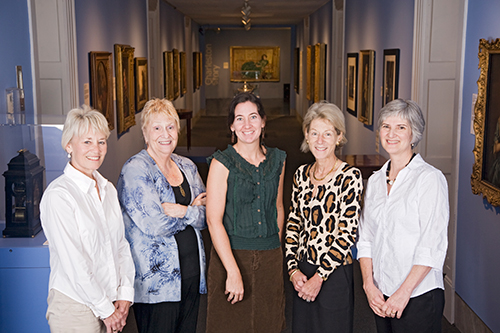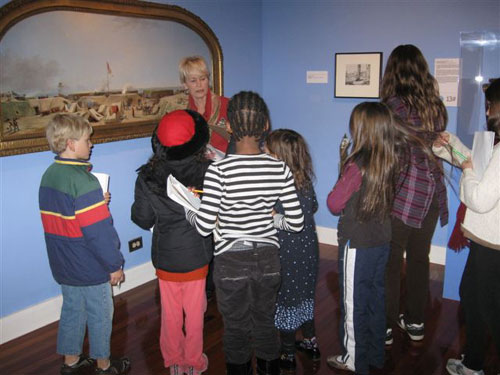
Once the school buses have parked, their exuberant passengers spill out onto Meeting Street and over the steps of the museum. We, their guides, are the first face of the Gibbes, and set the tone for their ensuing adventure. After negotiating 45–50 rambunctious students into 2 or 3 somewhat orderly lines, we’re ready to start the journey through our galleries. For most, it’s the first time they’ve been to the Gibbes, and therein lies the challenge. If this is to be successful—and hopefully spark an interest that may not be kindled were it not for this opportunity—how do you grab their imagination? How do you intertwine South Carolina and Charleston history, with its art and artists, in a memorable way in just 45 minutes?!
The collection is presented in chronological order, so usually we split groups: one starting with the earliest eighteenth century works; one in the nineteenth century; and one in the modern and contemporary galleries. It’s always so interesting to hear the children’s comments as they march along, gazing left and right down the hall of portraits; weaving around that dazzling silver soup tureen; entering the large room with the huge reclining figure of a woman in green; veering left, and finally heading up the stairs. Once settled in front of our first object, the fun begins when I ask the students questions to elicit their ideas about what they’re looking at.

Together we start a dialogue. Why is it important to actually see works of art up close and personal; to look at the brush strokes and notice how the paint or watercolor is applied, lines drawn, and shapes created? I ask the group to notice the subject’s face and hands: are they realistic or abstract? And what about the landscapes: do they appear detailed or impressionistic? We compare and contrast the different techniques. The hope is to instill in these young onlookers an appreciation for the everyday beauty of life. This visit may start the journey for some, who will discover a creative outlet to express themselves. For others, the experience may heighten their awareness of the artistry in one’s surroundings.
As funding for the arts nationwide has diminished, it is more and more difficult for schools to take field trips like these to museums. So this fall, some of the museum educators at the Gibbes will be heading out into surrounding South Carolina schools to take the museum on the road with the “Eye Spy” program, generously sponsored by the C. Louis Meyer Foundation. Each of us will be assigned to a different elementary school, where we’ll visit the third-grade art class once a month during the school year, ending with a visit to the museum. The concept is to familiarize students with art elements, techniques, and mediums by studying works of art from both the Gibbes collection and those of other museums. The hope is that multiple sessions with the same group of students will re-enforce and encourage an interest in art; and as I alluded to before, engender an appreciation of the artistry in everyday life. Sharing great works of art with young learners is both the joy, and the challenge, that makes what we do at the Gibbes so never-endingly rewarding.
—Barbie Kratovil, Museum Educator, Gibbes Board Member, and guest blogger
Published August 29, 2012

